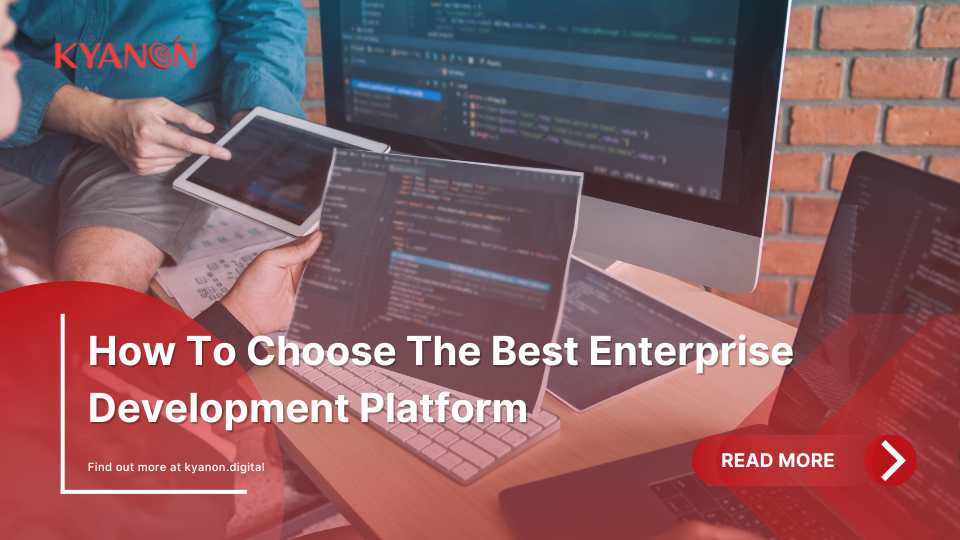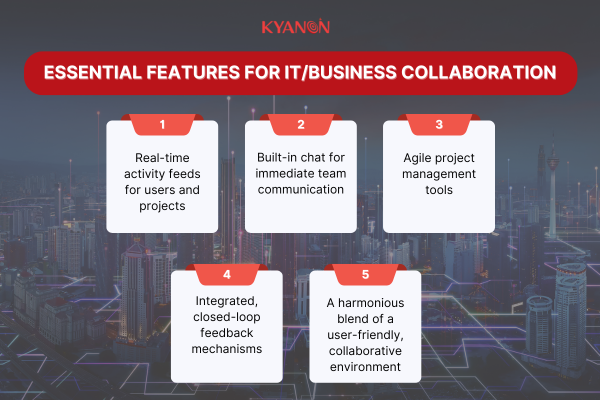The development platform market is vast and rapidly evolving, making it challenging to identify the optimal solution for your organization’s current and future needs. To assist you to choose the best enterprise development platform, Kyanon Digital has curated a list of essential questions to consider when assessing enterprise app platforms.

1. How easy is it to build applications?
Can non-developers contribute actively to the development process?
Enterprises today grapple with an escalating demand for new applications and features. To overcome traditional development hurdles and significantly boost speed, efficiency, and output, organizations require an application platform that breaks free from conventional constraints.
When evaluating development environments, it’s crucial to steer clear of proprietary programming languages that necessitate highly specialized developers. Such languages often introduce complexity and inflate costs without yielding substantial productivity benefits.
To accelerate delivery, consider an application platform rooted in a modern approach like visual, model-driven development (MDD). Unlike traditional code-based methodologies, MDD is intuitive, straightforward, and remarkably swift.

MDD empowers entire project teams, including non-developers or business analysts, to collaboratively create and refine executable application models. This visual approach fosters clear understanding, facilitates review, and enables swift modifications.
A Capgemini study underscores the efficiency gains of MDD, revealing that it requires only 2.5 hours per function point compared to 10.6 hours for Java and 15.5 hours for C#. This productivity surge can potentially condense a six-month project into a mere six weeks. Imagine the transformative impact this time compression could have on your business.
2. Can the platform build new apps and extend existing systems?
Can it seamlessly integrate with any system?
Enterprises leverage development platforms for two primary purposes: creating new custom applications and enhancing existing systems with innovative business capabilities. Therefore, a comprehensive platform must excel at both. While some platforms specialize in extending specific systems (e.g., CRM) or automating processes, they might fall short of addressing a broader spectrum of application delivery needs.
Irrespective of whether you’re building novel applications or expanding existing systems, seamless integration is paramount. Most businesses operate within complex ecosystems that necessitate connectivity beyond a single application.
The ideal enterprise development platform offers unparalleled flexibility, enabling the creation and integration of applications with any existing process or system. Essential integration capabilities include workflow integration, open APIs, pre-built connectors, and straightforward integration points. Additionally, consider how well the platform aligns with your IT organization’s existing development tools and practices.

3. Are there capabilities for IT/business collaboration?
Effective IT-business collaboration is the cornerstone of successful custom application development.
Many enterprise development platforms prioritize the developer experience while neglecting crucial collaboration features that enhance communication, productivity, and overall project success.
To foster seamless collaboration, seek a platform equipped with robust social and project management capabilities. These tools align and engage all stakeholders throughout the development lifecycle.
Essential features include:
- Real-time activity feeds for users and projects
- Built-in chat for immediate team communication
- Agile project management tools for user story creation, requirement definition, task assignment, prioritization, and progress tracking (e.g., scrum boards, burn-down charts)
- Integrated, closed-loop feedback mechanisms from end users to developers
- A harmonious blend of a user-friendly, collaborative environment and a model-driven development approach, where all team members share a common language, significantly amplifies project outcomes.
4. Can the platform deliver multi-device applications?
Enterprise mobile applications are in high demand. However, in the rush to meet business needs, it’s crucial to remember that mobile apps exist within a broader ecosystem.
Mobile apps typically require integration with backend systems and must cater to diverse user needs across multiple devices (web, tablet, smartphone). To address these complexities effectively, seek an enterprise development platform that enables the creation of truly multi-device applications connected to backend systems. This means building an application once and adapting it seamlessly for various user experiences and devices.
Ultimately, your users require a single, unified app accessible across different platforms. Redeveloping apps for each device or operating system is inefficient and unsustainable.

5. How fast and flexible is the process of deploying applications?
Deployment bottlenecks should never hinder project progress or burden development teams. When assessing app platforms, prioritize deployment solutions that are as swift and effortless as plugging in an appliance.
Platforms leveraging executable models, for instance, often facilitate cloud deployment with a single click. Beyond speed and simplicity, deployment flexibility is crucial. While cloud-based solutions frequently suffice, various business and technical demands necessitate alternative deployment options, including private cloud, on-premises, or hybrid environments.
Therefore, it’s essential to evaluate a platform’s capacity to support multiple deployment models. Even if not an immediate requirement, evolving needs can necessitate flexibility, preventing future complications.

6. Start building better apps with Kyanon Digital and Mendix
Mendix is a leading low-code application development platform that empowers businesses to build and deploy enterprise-grade applications rapidly. It bridges the gap between business and IT, enabling faster development cycles, increased agility, and improved collaboration.
Kyanon Digital is a strategic partner of Mendix. This powerful alliance leverages the strengths of both companies to deliver exceptional digital solutions for businesses. By combining Kyanon Digital’s deep industry expertise with Mendix’s innovative low-code technology, the partnership empowers organizations to accelerate their digital transformation journeys, enhance operational efficiency, and drive business growth.
Contact us for more information on low-code development and talk with our experts today!



